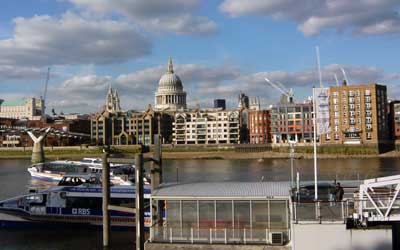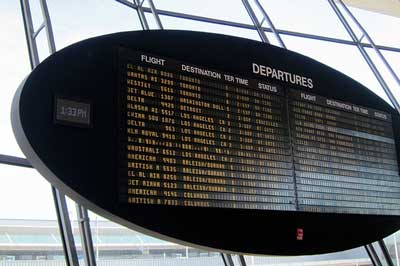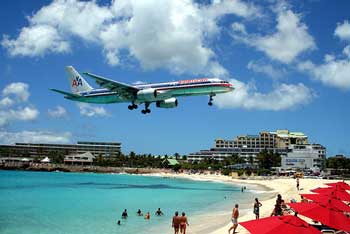Flights are cheapest 5 to 16 weeks out in 2019: Here’s when to book
Trying to find the absolute cheapest airfare for a trip you are planning is like playing a game that feels too easy to lose. Now in this era of ‘big data’ where many companies are able to check airfares on every route every day to calculate the cheapest possible time to buy, it’s finally a bit easier.
Only a few years ago the advice was often to buy between 4 and 6 weeks out, but things have changed and it really depends on where you are going. As you’ll see in the 2019 update below, the window for buying the cheapest fares starts earlier these days and buying about 4 months out often leads to the best deals. We’ve summarized a variety of studies below and with a quick scan you should be able to get some insight on when to buy and when to wait.
Note: This article was first published in 2012, and has been updated and revised each year as new information has come out, most recently in February, 2019.
2019 UPDATE: The data for 2018 has been similar to 2016 and 2017, but it's still complicated
As of 2019 there are quite a few different companies that are analyzing millions of airfare purchases in order to find the money-saving trends. They tend to show the same pattern, which is that buying two or four months early is the sweet spot for most tickets.
For the tests we ran below we used the very helpful tool from Cheapair.com.
Summary: Buying air tickets earlier will usually save you money
In years past the sweet spot for buying cheap tickets often didn’t start until 6 to 8 weeks before the flight, but the data from 2018 shows once again that the cheaper airfares are now usually available starting 4 to 6 months out in many cases. In other words, if you are sure you want to fly on particular dates, you can usually get something close to the lowest possible fare if you book almost half a year out.
Another interesting thing about the data is that once you reach the beginning of that “sweet spot” where fares are near their low for any given flight, they still bounce around by up to US$50 over the next couple of months before they start heading higher as the flight approaches. So the best strategy is to set an alert for fare decreases on the route that you are shopping for, and buy as soon as you get one of those dips.
North America to Europe: 7 to 16 weeks out is usually the sweet spot

As long as you are within that 16-week window, the longer you wait the greater the chance that the fares will start jumping up for good. This is especially true for popular travel periods such as July and August. In spring and autumn you can usually get away with waiting a bit longer.
North America to the Caribbean: Book 3 to 12 weeks out

The Caribbean hurricanes in 2017 won’t change anything, in case you were curious. The islands that were affected most are all small islands that only got a small percentage of Caribbean flights in the first place. The busy airports such as Cancun, Punta Cana, and even San Juan, Puerto Rico (which has fully recovered) should carry on the same as before when it comes to airfare windows.
North America to Asia/Pacific: 8 to 20 weeks is cheapest

The good news is that you no longer have to book so far in advance to get something close to the lowest fare. The more obscure your destination (Hanoi, Kathmandu etc), the earlier you should probably book. For more common destinations such as Tokyo, Singapore, and Bangkok, you have more time to wait.
North America to Middle East & Africa: 6 to 12 weeks is best
Another case where flight shoppers in 2019 can wait a bit longer to get a great deal than even a year ago, you should now be able to get a good fare to a place like Dubai, Abu Dhabi, or Cairo only 6 weeks or so out.
North America to South America: 5 to 16 weeks is cheapest
In 2019 there is a wider range for the lowest fares going from North America to South America. Many of these are not especially popular routes so there isn’t much competition on them. In cases like this it’s usually best to book early because if there is only one airline flying that route, you are vulnerable to a nasty surprise.
On short and popular routes, 3 to 4 weeks is usually fine

Flights within Europe: Buy as early as possible
In reality the cheapest fares within Europe are almost all on the low-cost carriers such as Easyjet and RyanAir. If you are flying on any of those airlines, the fares ALWAYS start out cheap and get more expensive as more seats are sold. So the cheapest time to buy on a low-cost airline is NOW (or as soon as tickets go on sale, which is usually 11 months out).
Flying on a low-cost carrier (even to Europe): Buy now

This is even true on Norwegian Airlines between the US and Europe. They offer the lowest fares in general on scores of popular routes, so if you are sure of your dates you should buy the tickets as soon as possible to lock in the lowest fare. They won’t be getting any cheaper.
Cheapest times of the year to fly
The trends above should be valid for flights for most of 2018 and into 2019, but there are a few times of the year that are always a bit cheaper than others. For this information we look to research from Rick Seaney of FareCompare, who has been doing this longer than anyone else.
Domestic US flights are cheapest
January 7 to March 5 (between Christmas Break and Spring Break)
April 18 to June 2 (between Spring Break and Summer travel season)
August 22 to mid December (most summer trips end and autumn is a slower season)
If you can fly in any of the periods mentioned above you are likely to get lower fares than if you fly during the traditionally busier periods.
US to Europe flights are cheapest
Before June and after mid August (summer season is by far the busiest, and it ends earlier than you might think)
Weekdays and especially Tuesdays and Wednesdays (Even more so than domestic travel, trans-Atlantic travelers like to travel Fridays through Sundays, so flying the other days will almost always be cheaper).
Cheapest time to book flights for Christmas and New Year's trips
According to a 2015 study by Skyscanner, the absolute cheapest time to book flights for the popular dates just before Christmas and New Years is August 10 to 16, at least based on their 2014 data. The study also shows that fares only inch up a bit in later August and into September, but that by early November the fares will be closer to their peak.
Previously we’d heard that it’s best to buy holiday flights as early as possible, which is usually 11 months out for most airlines. I think that’s still mostly true, partly because it will allow you to pick the best possible departure times in both directions. But if you aren’t quite so picky as to which time of day you leave and return, waiting until mid August seems like a decent idea and you’ll still get a relatively good fare.
Important exception: Book flights on low-cost airlines as early as possible, always
If you are thinking about booking a flight on a low-cost airline, such as Southwest or Spirit in the US, or EasyJet or Ryanair in Europe, or Air Asia in Asia, the cheapest fare will always be as early as you are ready to commit. Unlike the more traditional airlines, the low-cost carrier revenue model is based on starting with all seats as cheap as they’ll ever be when the flight is officially in the system. Then as seats are sold on that flight, the fare goes up as the plane is selling out. So maybe the first 20% of the seats are sold at the lowest price, and when those are gone, the next 20% are sold at a higher price, and so forth until all seats are sold or the plane takes off.
However, it’s important to consider the fact that “low-cost airlines” aren’t necessarily cheaper than their more traditional counterparts. Specifically, Southwest Airlines will often be more expensive than American or United, at least once the first group of cheap seats is gone. Also, since traditional airlines do in fact lower fares during the sweet spot of a few weeks to a few months before departure, you might find that waiting for those lower fares might be the best deal of all.
Flights are still often cheapest on Tuesdays and Wednesdays

My favorite trick for finding the best fares for an upcoming flight is to check for that route on a Wednesday and returning on a Wednesday. That will almost always show you the lowest possible fare, and then you can compare prices of other days of the week to see how much more you are willing to pay to fly on, say, a Friday or Saturday.
The advice: Check any and every day of the week, and if it’s the weekend you might want to wait a few more days to see if fares drop.
Why do airfares go up and down and up again as the day approaches?
Looking at the data above, you might think the airlines are playing some sort of game with flyers, but these pricing policies are actually a result of elaborate data and computer models that help them make the most money from each plane that leaves the ground. Here’s why:
People who buy plane tickets early are less price sensitive
In the world of economics they call this being “inelastic” in that in some situations consumers will buy almost exactly as many tickets, even if the price is higher. Airlines (obviously) want to maximize their profit for every seat they sell on the plane, so they take advantage of those who are driven to lock in early.
Consumers who buy early might:
- Already have set vacation days they want to use all of
- Be attending an event, such as a wedding, where there’s no flexibility
- Be someone who feels great stress until the ticket is locked in
In the above situations, whether a round-trip between Los Angeles and London is US$800 or US$1100, the person buying at least 3 months out is likely to buy either way. There is little incentive to airlines to sell a ticket for $800 if they’d sell almost as many at $1100.
People who buy plane tickets late are also less price sensitive
Similarly, consumers who are interested in flying 10 or fewer days from any given moment are also inelastic. They are likely to pay a premium for the convenience of going soon, so there’s little incentive for airlines to discount these tickets either.
Consumers who buy at the last minute might:
- Have just gotten approval for fixed time off soon
- Have an event on a fixed date (a football game, etc)
- Be someone who hates to commit to things early, and is willing to pay extra for the added flexibility
Now, keep in mind, that anyone who is hoping to fly in 10 days or fewer from now will see higher prices, and they’ll have the option of going 2 or 3 weeks later to save quite a bit of money. This price discrimination allows airlines to sell more expensive seats to those who can’t wait, and cheaper tickets to those who can.
What happened to cheap “last-minute” fares?

They tend to offer cheap flights between obscure city pairs on the least popular travel dates. So if you are ready to fly between, say, Charlotte and Bermuda this coming Saturday and return the following Tuesday, those last-minute deals could be for you. But for most of us, they never appear for places we really want to go and at times we want to travel.
Why no last-minute deals, you might ask? Why are airlines willing to fly with empty seats instead of filling them for low prices?
The reason airlines don’t lower prices for unsold seats at the last minute is that the last thing they want to do is condition travelers to wait until the last minute, hoping for a bargain, and then sometimes not flying at all when a bargain doesn’t appear.
Think about it. If you wanted to go from Los Angeles to London at some point soon, and a round-trip next month is $900, but if you go in 2 days it’s only $650, you are likely to buy the cheap ticket two days from now, or skip it and hope that the same deal is available next month when you are ready to go.
Airlines make more money on each plane-load of people if they condition passengers into buying earlier at higher prices, or very early at even higher prices.
When to wait for fare sales

If you are waiting for a fare sale and wondering when it might appear, it’s important to consider the airlines’ motivation in announcing them. Let’s say they announced an October fare sale in June, with round-trip fares way lower than those offered in summer. That would actually cannibalize their business for July through September. If someone is considering paying a high fare to fly in August, the airlines are not motivated to show them a much lower fare if they waited. That would lead to empty seats in late summer, which would be very costly for them.
In almost all cases you are best off waiting until 6 weeks or so before your departure date, but it’s also important to track the fares before that, and keep an eye on fare sales.
This same research by the AP also said that fare sales usually appear on Tuesdays and are over by the end of Thursday, so check fares early in the week and if a price drops then jump on it. They also found the highest fares showed up for those searching on Saturdays and Sundays, so you might be best off just skipping the weekends for fare research anyway.

Hi Roger! So happy to find this page. I’m planning on doing a one-way flight from the Los Angeles to AKL mid September, would it be best to wait until the 3 month mark or go ahead and buy now? Also, I’m planning on flying from New Zealand to Fiji, which airlines would be best for that, as well as returning from NADI to LA? And when should I purchase those tickets? Thanks so much in advance!
Grace,
Generally speaking, the trend has been that longer international flights, such as Los Angeles to Auckland, have had their lowest fares closer to the 6-month mark than the 11-week mark like before. It’s hard for me to confidently give you advice without knowing the travel dates and how flexible you might be, but most likely you’ll be best off buying very soon. For long distances like this the airlines know that most people prefer to plan way ahead of time rather than looking for last-minute deals, so they won’t sell many more tickets if they cut the price as the flight draws near.
Also, it can be stressful to keep waiting for fares to drop each week. With a route like this you might wait and get lucky by saving, say, US$100, but it probably won’t be more than that and it is probably more likely that the fare starts heading up to stay.
As for which airline to take, it looks like your nonstop choices are Air New Zealand and Fiji Airways. I’ve flown Air New Zealand and was pleased with them, but it looks like Fiji Airways flies planes that are slightly more comfortable and they also have a very good reputation. I think you’d be fine on either one, so choose based on flight times and fare offered. From Fiji to Los Angeles it looks like the only nonstop is on Fiji Airways (codeshare with American Airlines), and the fares I’m seeing are pretty good. I think I’d probably be ready to buy that ticket fairly soon as well, as long as it looks convenient and affordable to you. One problem with something like that is that it looks like there is exactly one nonstop flight per day from Nadi to LAX, and any other flight would require 2 stops and be much more expensive. In that case, it can be risky to wait to book a flight when there is only one good choice. You might check tomorrow and it has gone up by US$300.
Lastly, you should also check the Fiji Airways website and maybe even call them. You might be able to get a fairly cheap flight from Auckland to LAX with a long stopover in Fiji. Air Tahiti Nui has offered those stopovers for years and they can be a very good deal. Best of luck. -Roger
Roger, does it matter if you are using credit card miles in regards to when flight prices usually drop? Thanks!
Maureen,
If you are referring to the system where you can use credit card miles to buy any ticket, in place of cash, then they work on the same timing as cash. The other system where flights are only available in small numbers for people with enough miles, that is totally different and more or less the opposite of the cash system. Best of luck and let me know if you have a more specific question I might help with. -Roger
Hi Roger,
My partner and I are planning a vacation to London between 8/13/15 to 9/6/15. We’re going to be leaving from Boston. We’ve constantly been checking flights weekly. As of now the price ranges from $1100-1200+ with one stop layover and $1200-1300+ direct flight. Earlier in January the cheapest flights we saw was around $850. At that time we weren’t ready to purchase just yet. Do you think the flights would become cheaper within 2 months before departure? Or is it best just to get it now before price raises? Thank you in advance!
-Peter J.
Peter J.,
At other times of the year I’d say there was a decent chance that the fare might drop again, but August is obviously one of the busiest months for flights and it’s especially busy for Europe. My best guess is that the fares will probably just go up from here on out for those dates. The lower prices are coming earlier in the cycle these days, at least on longer flights like this, and since it’s high season, the airlines know they’ll sell the seats so they don’t have to discount them. If you were going in November, I’d say you might see another price drop coming, although that’s a bit of a gamble as well. Best of luck with this. -Roger
Hi Roger,
Thank you for this helpful post! I’m trying to book a ticket from NYC to Paris (for the first 2 weeks of June) and had used AA’s hold system to compare/rebook the fare. Of course, the one time I missed it was yesterday and the price jumped $300. I see that it’s matching AF/Delta’s pricing to within $5 – should I bite the bullet and book now or wait and see if it decreases over the next few days (hoping that it was auto matching Delta and will come down come Mon/Tues)? Thanks!
Kim,
If you are trying to book a flight from NYC to Paris leaving about a month from now, I would not wait long. The strategy of waiting until Tuesday to see if the fare drops again should be okay, especially if you are a bit flexible and might be able to change to a different flight if you had to. But after these next couple of days goes by, you run the risk of all of the flights going up in price and staying up. Best of luck and I hope this works for you. -Roger
I am trying to get a ticket asap from OH to NY in July. How long before the price goes up?
Michelle,
If you really want to go on specific dates, and especially on weekends, then I’d buy very soon. If you are flexible and can go on a Tuesday or Wednesday then you might see fares drop a bit in May. But generally speaking, July is a very busy month to fly, so fares won’t go down much and they might just keep going up. Best of luck. -Roger
wow – thanks for answering all those questions!
For Boston to San Juan, Puerto Rico, next February 2016, Sat to Sat . . . same pattern? I noticed if I book now it’s about $450 but if I bought for only 6 weeks from now it’s $360 RT. Does this hold true in winter?
Matt,
This is an interesting one. Flights into the Caribbean are famously cheapest only 2 or 3 weeks out, and I’ve confirmed that from many recent tests while checking fares from my current location in Miami. But, a Saturday to Saturday holiday in February is nearly “peak season” conditions in the Caribbean. I think if I were you I’d buy soon and just get it over with. In late April, we are starting into the low season in the Caribbean, so flights are cheaper in general. February, as you know, is high season.
So long story short, you could wait and wait and there is a chance that the fares will go a bit lower, but for weekend flights in February, I would not be surprised if they just stayed high and went higher from there. And to be honest, $450 RT for Boston to San Juan sounds pretty good to me for high season. Good luck. -Roger
Hi Roger,
We are planing a trip to China Beijing during the Chrstmas time 2015. Should we start looking for the tickets now?
Thanks in advance for your advise.
Jenny,
Yes, I think you should think about booking your flights soon, especially if you prefer to travel on the convenient days (weekends) around the Christmas holidays. The airlines know they can sell out all of those planes so they don’t have any incentive to cut fares to fill them up like they do for non-holiday periods. Best of luck. -Roger
I’m planning to fly from Singapore to London, Oct 17 to Oct 31. When is the best time to book my tickets?
Nadia,
If your dates are fixed, it means that you are going on a long international flight from a Saturday to a Saturday. In that case I think I’d be ready to book very soon on those flights because those Saturday flights will tend to fill up long before Tuesday or Wednesday flights in the same week. In other words, if your dates are somewhat flexible you can probably wait for as long as 2 or 3 months, and you might find that fares have dropped on some midweek flight at some point. But if you really prefer to fly both directions on a Saturday (or Sunday), then you are less likely to see fares drop in the coming months.
The most recent 2015 studies have shown that longer international flights are showing their cheapest fares closer to the 6 months out mark rather than 3 months like before. The good news is that those studies also show that fares don’t start climbing rapidly until maybe 6 weeks out, so booking soon isn’t an emergency. Best of luck with this. -Roger
What a fantastic page…………thank so much Roger Wade
I know I want to fly from Australia to London in May and return the end of July.
I want to book a tour of Europe while I am over there so I would need to book my International flights first so I can then book the tour. I am fairly sure that September would be the earliest I could book…………..is this correct?
Michelle
Michelle,
Thanks. Yes, airlines only sell tickets for flights starting about 11 months in advance in most cases. I think it’s mostly so no one buys a ticket for the wrong year.
In the case of your trip, you might get a good deal on 2 one-way flights rather than one round-trip so it’s worth comparing those on test dates just to see. If so, you could buy the May, 2016 flight starting in June. The flights for this will probably be cheapest about 6 months out, so there is nothing to be gained by buying almost a year early. Also, any organized tours of Europe will have plenty of available spots even 2 or 3 months out, so you don’t need to book that too far in advance either. Best of luck and have a great trip. -Roger
If I want to fly to Israel in August which is peak season am I best off buying tickets now or waiting another few weeks?
Color,
Especially since you want to go in peak season, I’d look into buying very soon. The most recent tests are showing that fares are cheapest close to 6 months out for longer flights. You don’t mention your starting country, but I assume it’s not close to Israel. If that’s the case, I think fares are more likely to go up slowly at this point rather than drop again. Best of luck. -Roger